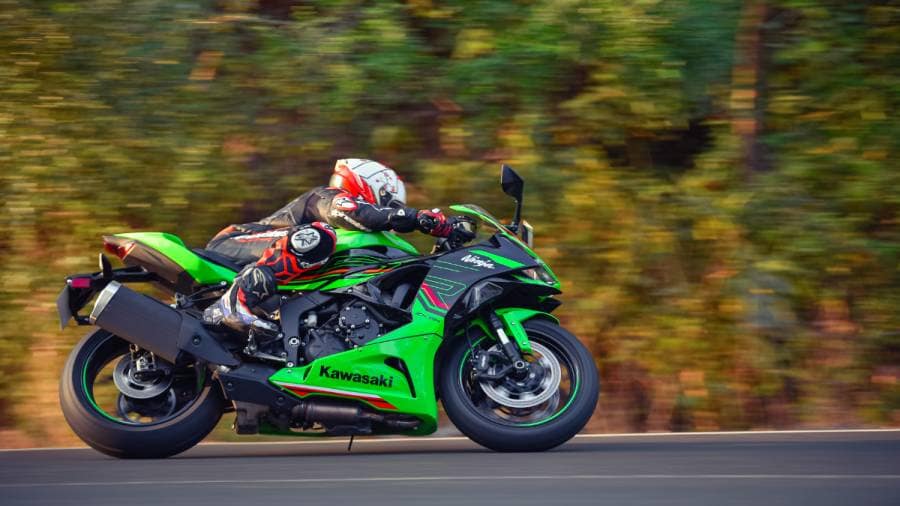2024 Kawasaki ZX6R Review - What's new and is it worth the money?
As the iconic Kawasaki ZX6R makes its return to the scene, one might wonder if its revival will spark the same fervour among riders as it did in years past. In an era dominated by the allure of street nakeds and adventure bikes, the middleweight supersport segment finds itself at a crossroads, grappling with declining interest from both returning and new-generation riders. The landscape of motorcycling has shifted, with many enthusiasts opting for the comfort and versatility offered by alternative machine types.

The allure of the once-revered 600cc supersport has waned, partly overshadowed by the allure of more feature-rich litre-class track machines. With advancements in technology and electronics, these larger-displacement bikes no longer pose the daunting challenge they once did, drawing riders directly into their fold once they've outgrown smaller displacement models.
Yet, amidst this shifting paradigm, Kawasaki stands as a beacon of the middleweight supersport tradition. Since its groundbreaking introduction of the 636cc ZX-6R in 2002, the brand has remained steadfast in its commitment to the supersport class. Now, in an automotive space where such models are becoming increasingly rare, Kawasaki's dedication to the genre is a testament to its enduring legacy and one that deserves applause.

But amidst a market largely characterised by stagnation, the question arises: What does this latest iteration bring to the table, and is it worth your hard-earned money?
Design and FeaturesVisually, the 2024 ZX-6R bears a resemblance to its predecessors but receives subtle yet noticeable updates inspired by its siblings like the ZX4RR and the ZX10R. But there is no denying that the colour scheme does little to differentiate it from its much more docile sport touring sibling - the Ninja 650R. The ZX6R's redesign incorporates new front and side cowls, LED lights all around, and a 4.3-inch full-colour TFT display, replacing the previous LCD gauge. These enhancements not only lend the bike a more modern appearance but also elevate the rider's interface experience. There is the connectivity option with the Rideology app which lets you sync calls and track rides, but there is no way to time your laps - neither on the app nor on the instrumentation.
Revised Engine
Under the hood, or rather, beneath the fairings, lies the familiar 636cc inline-four engine from a decade ago. In its current state, it uses revised cam profiles and exhaust layout to meet the stricter Euro 5 emissions standards. The powerplant feels quicker off the mark and has better low end punch, but it has lost some of its top-end shenanigans. The power seems to taper off earlier than the redline and it struggles to even reach 250kmph. The introduction of the new camshafts with lower lift profiles and shorter duration aims to optimise exhaust emissions while maintaining performance standards within the limit of the current displacement. Further enhancing the engine's efficiency is the integration of a larger exhaust pre-chamber and a repositioned O2 sensor.
The new instrumentation makes for better human and machine interface, which has now allowed Kawasaki to incorporate four ride modes - Sport, Road, and Rain presets. Sport and Road allow full power but with Low and Medium Traction Control respectively. Rain lowers power and increases traction control sensitivity. There is Rider mode too which lets you choose the low or full power map and turn off Traction Control if you wish - hence limiting its use case scenario. Utilising a Bosch 9.3MP ABS unit, the ZX-6R's braking system has been fine-tuned for smoother operation, providing more confidence-inspiring stopping power in various riding conditions.
Riding Experience
Where the ZX-6R truly shines is in its ability to offer an excellent riding experience akin to a classic middleweight supersport. The slightly better low and midrange grunt, coupled with a well-balanced chassis, allows riders to push the bike with confidence through corners and out of tight bends. Equipped with Showa Separate Function Fork - Big Piston (SFF-BP) front suspension and a rear shock, the ZX-6R delivers responsive handling and precise feedback, ensuring maximum control and stability in dynamic riding scenarios. That said, it does feel a bit heavy and a bit of work around switchbacks, when moving from one side to another. And this is where the platform shows its age. In the hands of a capable rider, the Street Triple 765 RS could not only keep up but also post quicker lap times, purely on the merit of its agility.
Value Proposition
With a competitive price point and a heritage rooted in performance, the 2024 Kawasaki ZX-6R presents itself as a compelling option for riders looking to transition from smaller-displacement machines to a middleweight sportbike. While it may not boast the most advanced features or cutting-edge technology, its simplicity and reliability are virtues that resonate with both novice and seasoned riders alike.
Verdict
In conclusion, the 2024 Kawasaki ZX-6R may not revolutionise the supersport segment, but it doesn't need to. By refining its design, enhancing rider amenities, and maintaining a potent powertrain, Kawasaki has reaffirmed its commitment to delivering a formidable middleweight contender. Whether you're carving canyons on the weekend or honing your skills at the track, the ZX-6R offers a compelling blend of performance, agility, and affordability that's hard to ignore.
So, is it worth the money? For riders seeking an exhilarating yet approachable sportbike experience, the answer is a resounding yes. The 2024 ZX-6R stands as a testament to Kawasaki's enduring legacy in the world of two-wheeled performance, promising thrills aplenty for those who dare to ride.